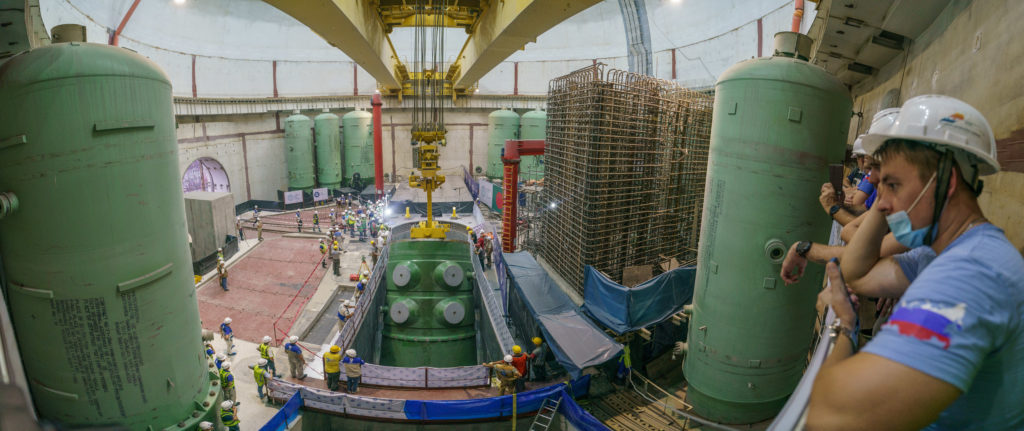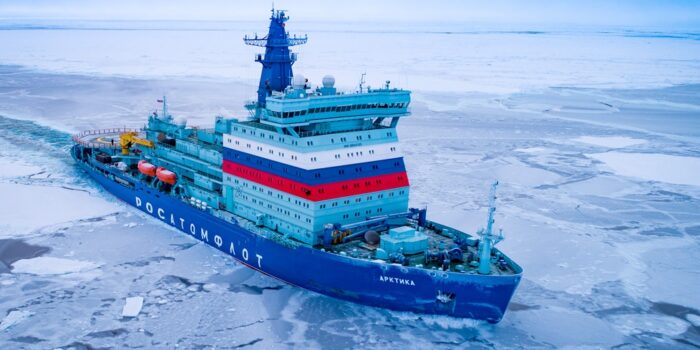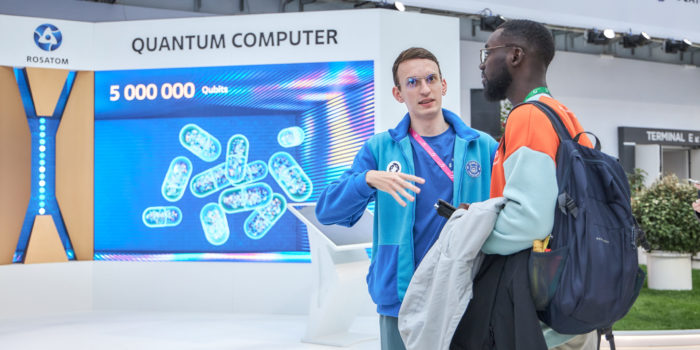Water-cooled water-moderated (VVER) reactors are key products offered by Rosatom in the large power reactor segment. Its flagship reactor is VVER-1200, which is an evolution of VVER-1000 reactors built in India (Kudankulam) and China (Tianwan) in the 1990s and 2000s.
The new design demonstrates improved performance across all parameters and a range of additional safety systems preventing radioactive substances from getting out of the leak-tight reactor containment in emergencies.
Overall, VVER-1200 features:
- Increased power output
- 60 years’ service life with the possibility of extension
- Load following capabilities
- High capacity utilization (90%)
- 18 months without refueling
- Other improved parameters
The VVER technology is based on a thermal neutron reactor with a two-circuit steam generating system. Pressurized ordinary water is used as a coolant and a neutron moderator.

The system consists of four cooling loops with a steam generator, a primary circulation pump, a pressurizer, relief and emergency valves on steam pipes, and accumulator tanks of the emergency core cooling system (ECCS).
Cutting-edge technologies incorporated into the VVER-1200 design, such as a spent fuel pool inside the containment, containment ventilation filters, a core catcher with a special material, and an unparalleled passive heat removal system, undoubtedly make VVER-1200 a Generation III+ reactor.
ECCS solutions are no less interesting. If the reactor pressure vessel or pipeline ruptures, a pressurized boric acid solution contained in the ECCS tanks is introduced into the reactor core, stopping the chain reaction and cooling down the reactor. Combined with other systems, the ECCS guarantees an extreme degree of reactor safety.
The VVER-1200 reactor was designed at OKB Gidropress (Podolsk) under the supervision from Kurchatov Institute (Moscow) and is manufactured at Atommash (Volgodonsk).
Rosatom was the first in the world to commission the latest Generation III+ VVER-1200 reactor built at Novovoronezh II Unit 1 in 2016. The same-type reactors operate at the Leningrad NPP.
In 2021, Belarus Unit 1 was brought online to become the first Russian-designed Generation III+ reactor to be put in operation abroad.
VVER-1200 combines reliability of time-proven engineering solutions with a range of active and passive safety systems compliant with the post-Fukushima requirements. The active safety systems are designed to quickly respond to possible accidents and emergencies. The passive systems need no human involvement to contain any emergency situation. The VVER-1200 reactor meets all the IAEA safety standards and requirements.
VVER reactors boast 1,500 reactor-years of safe operation. More than 80 VVER reactor units have been built in Russia and other countries over the last 50 years. Rosatom’s portfolio of international contracts encompasses 34 power units in 11 countries.
The VVER concept was first proposed by S. M. Feinberg from Kurchatov Institute. Engineering studies began in 1954. In 1955, OKB Gidropress joined the research and development project supervised and coordinated by I. V. Kurchatov and A. P. Aleksandrov.
Known abroad as PWR (pressurized water reactor), the VVER technology is a backbone of the world’s nuclear power industry. The first PWR was put in operation at the Shippingport Atomic Power Station (USA) in 1957. In the Soviet Union, the first VVER reactor (VVER-210) was brought online in 1964 at the Novovoronezh Nuclear Power Plant. The first VVER-based nuclear station abroad was commissioned in 1966 in Rheinsberg (German Democratic Republic, now German Federal Republic).
You can learn about Rosatom’s major NPP construction projects on the Atomstroyexport website.





